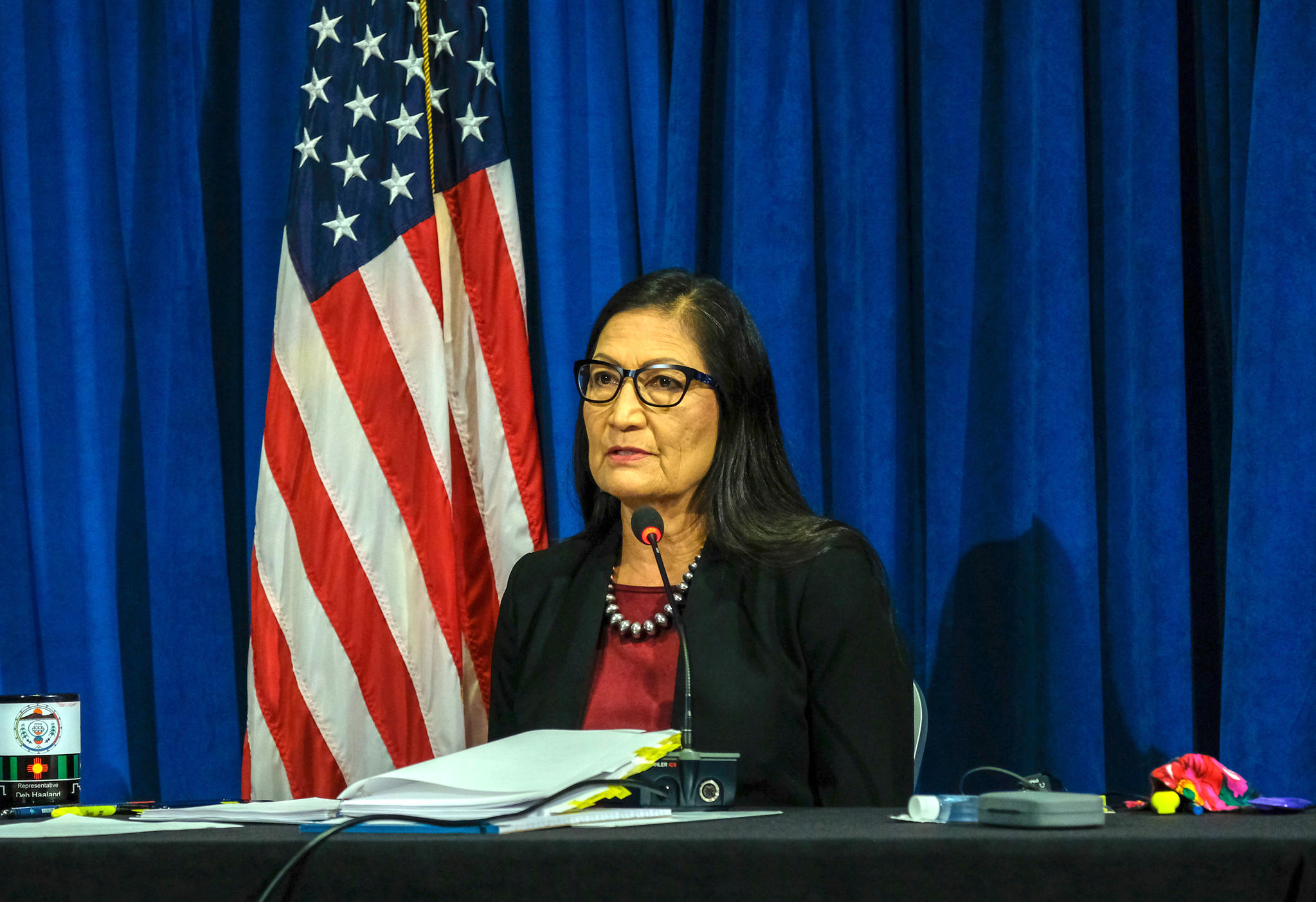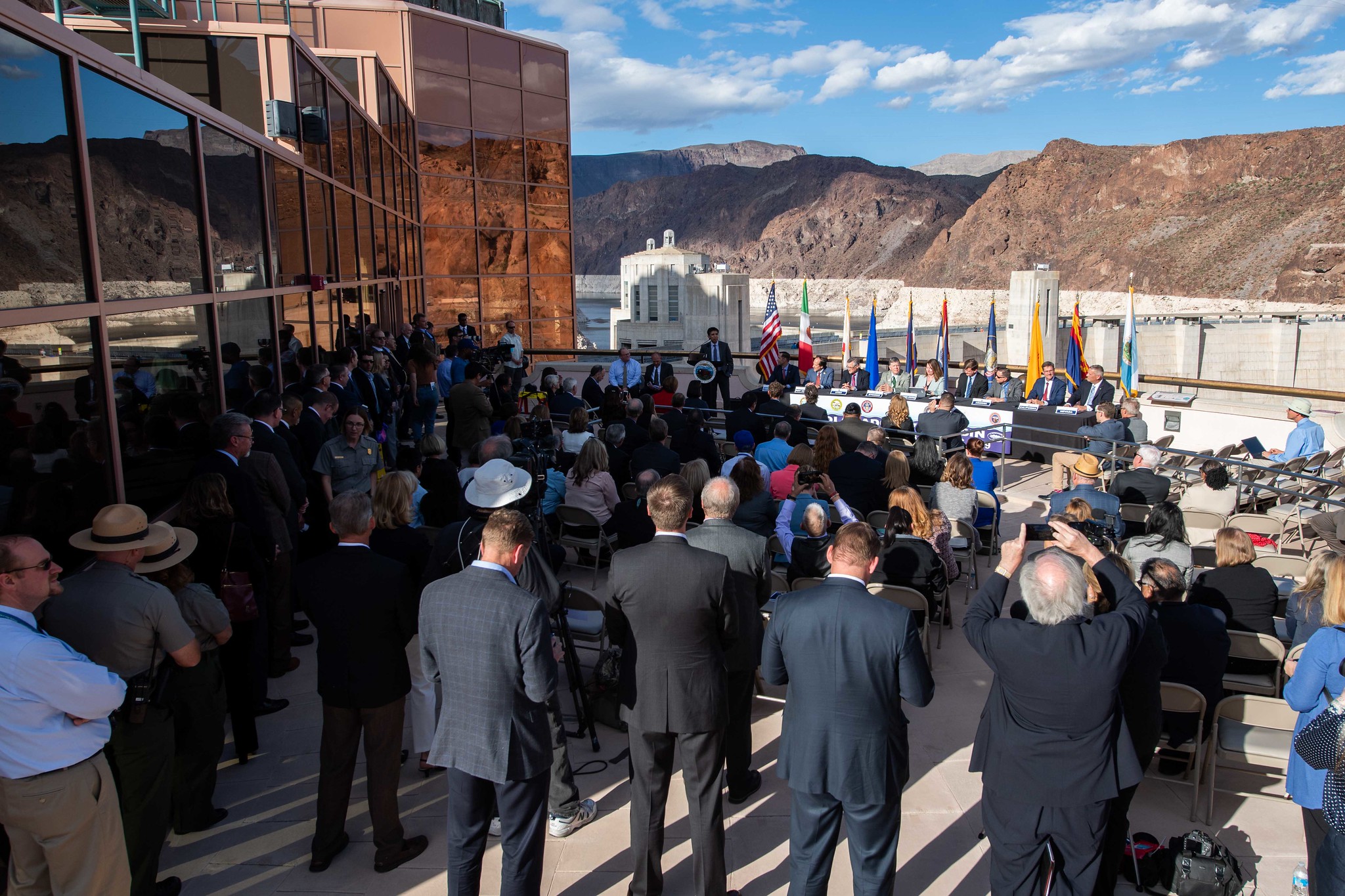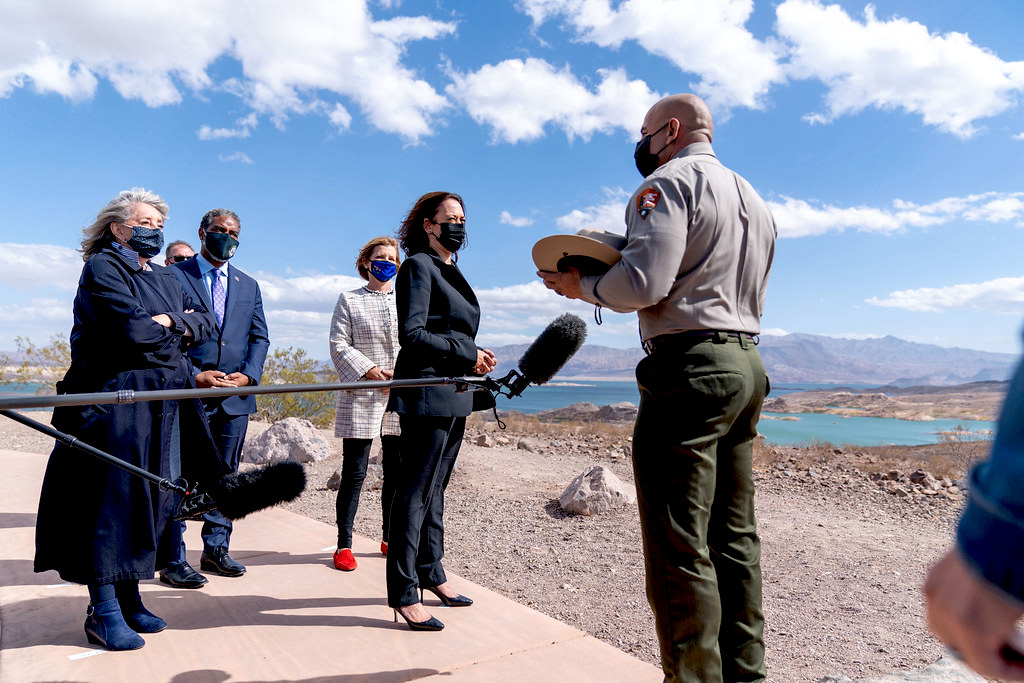An environmental watchdog says the administration’s plan to cut water allotments ignores the overexploitation of water by corporate agriculture and fossil fuel industries.

U.S. President Joe Biden in February. (White House/ Adam Schultz)
By Kenny Stancil
Common Dreams
After the Biden administration this week released proposals to cut water allotments to the states that depend on the shrinking Colorado River, a progressive advocacy group criticized federal officials for failing to address an underlying cause of the region’s hydrological plight: the overexploitation of water resources by the corporate agriculture and fossil fuel industries.
“Any legitimate plan for the Colorado River must directly confront a key driver of the crisis in the first place: the overuse and abuse of limited water resources by big agribusiness and fossil fuel corporations — the very same industries contributing to climate chaos in the first place,” Food & Water Watch executive director Wenonah Hauter said in a statement.
The seven Colorado River Basin states — Arizona, California, Colorado, Nevada, New Mexico, Utah, and Wyoming — have missed multiple federal deadlines to finalize an interstate water conservation pact.
Following months of fruitless state-level attempts to forge an agreement on how to preserve the region’s waning water resources, the U.S. Department of Interior’s Bureau of Reclamation proposed two solutions in a draft analysis published Tuesday.
The agency also explored the devastating implications of a third alternative — doing nothing.
As The Associated Press reported:
“One option would be more beneficial to California and some tribes along the river that have high-priority rights to the river’s water. The second option is likely to be more favorable to Nevada and Arizona, who share the river’s Lower Basin with California and say it’s time for an approach that more fairly spreads the pain of cuts. That approach would force cuts on a proportional basis, when water levels at key reservoirs along the river dip below a certain point.”
The two plans unveiled by the Interior Department “would achieve at least 2 million acre-feet of cuts in 2024, on top of existing cuts that states and other users previously agreed to,” AP noted. “States, tribes, and other water users now have until May 30 to comment before federal officials announce their formal decision.”

U.S. Secretary of the Interior Deb Haaland giving congressional budget testimony in April 20, 2021. (U.S. Department of the Interior)
Since the Colorado River Compact was originally signed in 1922, the 1,450-mile waterway — a lifeline for 40 million people in the western U.S. and northern Mexico — has been over-allocated.
Making matters worse, historic drought conditions intensified by the fossil fuel-driven climate emergency have exacerbated scarcity, jeopardizing drinking water provision and power generation throughout the region, including in the metropolitan areas of Los Angeles, Phoenix, San Diego, Denver, Las Vegas, Albuquerque and Salt Lake City.
The amount of water being withdrawn from the Colorado River has declined since 2000 even as more people have moved to the area.
But with less water flowing into the river amid the West’s 23-year megadrought — more severe than anything seen in the preceding 1,200 years — recent reductions in per capita water consumption are insufficient.
Meanwhile, Wall Street investment firms are looking to capitalize on the pending calamity by buying and selling rights to the river’s dwindling water supplies.

State and federal officials at the Hoover Dam, on the border between Nevada and Arizona, signing drought contingency plans, May 20, 2019. (U.S. Bureau of Reclamation)
In light of this alarming predicament, Hauter said Tuesday that “federal and state officials must work together to protect the Colorado River as a public trust resource and prioritize the well-being of Western communities before corporate profits.”
“The Biden administration and governors must find the political will to stop the expansion of water-intensive factory farming, including megadairies and egregiously thirsty crops like tree nuts and alfalfa,” said Hauter. “They must halt these practices and chart a course to a more sustainable and resilient future, one that aligns with the reality of climate change and our precarious water future.”
As much as 80 percent of the Colorado River’s water is currently “put towards agriculture, and 80% of that supply is used for crops like alfalfa, which is largely used as feedstock for cattle,” according to Food & Water Watch. “The current framework to cut water uses, however, focuses on overall allocations and makes only a passing reference to the actual purpose that water is used.”
“Each industrial, municipal, and agricultural user should be held to the highest industry standards in handling, using, and disposing of water,” the watchdog added. “There is precious little water left to waste.”
In February, after California refused to sign onto the other six Colorado River Basin states’ blueprint to collectively slash water use by 15 percent —- the bare minimum experts say is necessary to prevent water levels in dangerously depleted reservoirs from dropping even further — Food & Water Watch published research detailing “the toll that corporate agriculture and fossil fuel drilling is taking on the state’s beleaguered water supplies.”

U.S. Vice President Kamala Harris tours Lake Mead, which was at record low water levels, on Oct. 18, 2021, in Boulder City, Nevada. (White House/ Lawrence Jackson)
As the group said, a huge expansion since 2010 in the number of acres devoted to growing almonds and pistachios required 523 billion additional gallons of water for irrigation in 2021 compared with 2017 — an increase equivalent to the recommended indoor water use of 34.1 million people, or 87 percent of California’s population.
In addition, irrigation for the lucrative alfalfa industry devours nearly 1 trillion gallons of water per year, and corporate megadairies guzzle nearly 52 billion gallons of water annually.
With large quantities of California’s nut crops, alfalfa, and dairy products being exported around the globe, billions of gallons of the region’s sorely needed water resources are effectively shipped overseas.
The report also pointed out that planet-heating oil and gas producers in California consumed 3 billion gallons of freshwater from 2018 to 2021.
But California-based firms are not alone in mishandling the Colorado River’s water resources. Food & Water Watch has also estimated that New Mexico’s megadairies consume 365 million gallons of water every year while generating substantial amounts of pollution.
Food & Water Watch has long called for implementing just and sustainable water policies that don’t let the industries most responsible for the West’s water crisis off the hook.
Last August, after Colorado River Basin states failed for the first time to reach an accord for reducing water use by at least 15 percent, the group’s research director, Amanda Starbuck, urged policymakers to “eliminate rampant corporate water abuse before it’s too late.”
“By switching to renewable energy sources like solar and wind, California could save 98% of the water currently needed for its fossil fuel production,” Starbuck said at the time. “And by transitioning away from industrial megadairies, thirsty crops like almonds and pistachios, and engaging in regenerative farming, California will gain enormous water savings that could serve small farmers and domestic households.”
Food & Water Watch’s February report implored Democratic California Gov. Gavin Newsom to “use executive and emergency powers to immediately stop egregious misuses” of water.
“This includes preventing the planting of new almond and alfalfa acres on the salty, dry west side of the San Joaquin Valley, banning new megadairies, and ending new oil and gas drilling,” researchers wrote.
Kenny Stancil is a staff writer for Common Dreams.
This article is from Common Dreams.
The views expressed in this article and may or may not reflect those of Consortium News.

I am grateful for article on an important topic, with many facts and numbers. In the same time, there is some lack of the sense of proportion between these numbers.
” irrigation for the lucrative alfalfa industry devours nearly 1 trillion gallons of water per year”, let us view this as problem of size 1000.
“corporate megadairies guzzle nearly 52 billion gallons of water annually”, so a problem of size 52
“[almonds and pistacchios] 523 billion additional gallons of water for irrigation in 2021 compared with 2017 “, problem of size X + 523, it seems that the production tripled
“oil and gas producers in California consumed 3 billion gallons of freshwater from 2018 to 2021.” in terms of fresh water resources, problem of size 0.75
A remark on New Mexico: Alburquerque water supply and New Mexico dairy industry is probably the issue of Rio Grande basin in 90% or more.
There are many agriculture products in Colorado river basin, but dairy fodder and nuts seem to be top problems (and oil/gas production, practically none). What is a bit bizarre is dairy fodder issue. It can be lucrative only because of water rights delivering water to farmers at the cost not reflecting scarcity. In the same time, there is plenty of space where this fodder could be produced, together with milk products (ca. 1/7 of milk is used for liquid products, the rest can be transported with no problems). However, the space where this fodder (mostly alfalfa) could grow is used for corn destined to gasoline tanks. Cut the size of gasohol boondogle, encourage the use of efficient cars (a combination of smaller size, hybrid/electric engines, and move fodder production to Midwest where water comes from the sky.
I conjecture that the best mechanism would entail severe cut in gasohol program, so Midwest farmers would need to find other cultures, including alfalfa and vegetables that are too expensive in USA compared with Poland and Germany (so lower income people cannot afford healthy diet even if they got convinced to pursue it), increase the price of water in areas like Colorado River basin where the supplies are shrinking — perhaps Rio Grande basin is one of them. For that matter, rapid urban/suburban development in those areas would better stop.
I assumed that since almonds and pistacchios do not thrive in Nebraska and Michigan (I may be wrong here), the growers will be still in business even when water costs will increase. Similarly, why rice is farmed in California if the areas near Gulf of Mexico are excellent for rice?
The issues of global warming and climate change will steadily become more intense and more ubiquitous, not just for us but for every generation to come, for centuries. That is the new reality that will not go away. All of the current talking and plans from our corporate elites dance around the core issue while deflecting with various and assorted silver bullets and technological innovation. It’s all vacuous tripe. Simply plans to keep on doing what we’re doing; close your eyes and wish it away. But there is no negotiating with Mother Nature. What is required for dealing with climate effects is fundamentally life-style changes. We can whine and moan all we want but again, Nature neither negotiates nor cares. Water is wet and space is big, like it or not. And eventually, sooner rather than later, we either choose differently or have choices, which are no longer choices at all, imposed upon us. Every day of more of the same that passes will make that imposed choice more and more unbearable. In the face of all this, the least qualified people are literally deciding our fate with their eyes fixed firmly on the past. And they have been elected.
Sit back and enjoy watching modern American politics finally meet the immovable object known as Mother Nature. Humans can dicker and complain and assert rights and wave legal papers all they want…. but none of that makes more water in the river. Sooner or later, the amounts taken from the river needed to match the amount in the river. Sooner would have been better, but now that we are at later, the accounts will require balance. Emperor Joe might be able to issue decrees, but Mother Nature will still hold a veto.
BTW, aren’t Los Angeles and San Diego next to a very large body of water? Removing the salt is not impossible. So, what capitalism is really saying is that it is ‘cheaper’ to use scarce river water instead of desalinating. Society could make another choice, if its philosophy allowed.
Desalinisation cost in dollars and carbon does matter. Theoretically, wind/solar energy could be good for that purpose, because variable availability is not an issue: as long as at least some water comes from distant reservoirs, you decrease reservoir depletion when sun/wind is plentiful, and draw the water at other times, no issue with electricity storage. But doing all of that to spare some dairy farms would be a bad economic calculus.
Food and Water Watch assumes that production of livestock feed is a bad thing without acknowledging that there are natural resources relationships that continue for generations like in New Mexico. Agriculture is a lifeblood in New Mexico, Facebook server farms are not. As a semi native whose work involved Project Management for water reservoir studies for New Mexico and working on water plans for the Rio Chama and with the communities in Union County and preventing fracking in the Rio Grande Basin. That said, I find the Biden administration out of touch including at the cabinet level with Secretary Haaland. We have in fact only one sole source aquifer protected in New Mexico in these many years and even the Democratic Governor, Michelle Lujan Grisham, and our US Congresswoman Stansbury and US Senate members Ben Ray Lujan and Martin Heinrich have failed to make acquifer water protection a priority.
One wonders how any real progressives or liberals can back this administration. If any who did had an ounce of integrity, they’d be apologizing and backtracking like crazy. The road to Hell (or perdition, if you’re not a deist), is paved with what pass for good intentions but are usually just cognitive deficiencies.